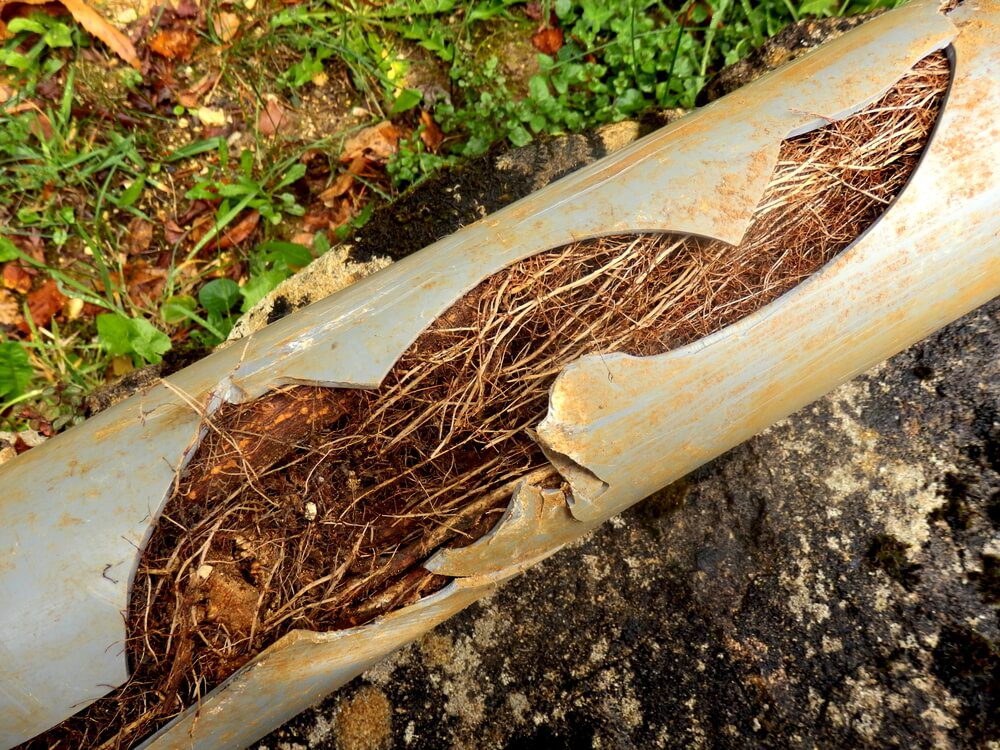Blog
Plumbing Problems: Tree Roots in Sewer Line

Does it take a while for your water to drain? Do you notice foul sewer odors in the yard? Sometimes, your sewer drain system gets invaded by tree roots. Trees growing near underground sewer lines send out long feeder roots in search of nutrients and water.
Sewer pipes contain water and organic waste, becoming a prime target for trees. Older homes using clay pipes, especially the Orangeburg pipes, have mortar-filled joints or concrete pipes that are especially vulnerable to tree roots.

An aggressive tree root invasion can overtake any pipe with seams, holes, or leaks. Once they get into the pipe, clogs form, with debris getting stuck on the roots and eventually backing up the sewer line. The result is expensive sewer backflow into the house. These roots naturally grow and expand toward any leaks in your sewer line, seeking out the water.
Once they find the source of the leak, they invade your pipe and cause blockages. These blockages can become costly repairs. In this article, we’ll cover the warning signs of tree root invasion, how to prevent root invasion, and how to avoid hefty repair bills.
Warning Signs of a Sewer Line Tree Root Invasion
Here are some signs that tree roots are clogging your drains:
- Clogged Drains: Slow drains are the first sign of tree roots in the main sewer line, especially if it seems to recur.
- Gurgling Sounds: Tree roots may cause gurgling sounds after flushing the toilet.
- Blocked or Collapsed Pipes: This becomes apparent when a drain or toilet backs up. Sometimes, it's because someone flushed something they shouldn’t have, but it can also be due to tree roots in the drains.
- Sinkholes: If you discover a sinkhole in your lawn, it could be caused by tree roots collapsing your pipes. This warning sign means you have advanced sewer line problems. This level of damage can also put your home’s foundation at risk.
- Foul Odors: When roots have penetrated sewer lines, foul smells escape from the pipe and work their way up through the ground. If you smell rotten eggs or sulfur, you could have a serious sewer problem.
You should call a professional plumber if you’ve noticed any of these tree root plumbing problem signs.
Potential Damage From Tree Roots in Sewer Lines

Tree roots stretch long and far, seeking out water. Holes in pipes that aren’t properly addressed or sealed can leave your pipes vulnerable to tree roots, causing plumbing problems.
Roots have hair-thin strands that delve into pipes. When these strands are combined with grime, grease, fat, toilet paper, or other gunk, then toilets, sinks, and other drains will drain sluggishly or even back up. Nothing is nastier than wastewater backing up a drain and seeping into your home.
These tree roots find your pipe’s vulnerable places and widen them, causing pipe cracking. Clay pipes in older plumbing systems are especially susceptible to tree root damage.
3 Tips to Avoid Tree Roots in Sewer Line Pipes
The best way to control tree root problems is to prevent them in the first place. Here are three ways to avoid tree roots in the sewer line drain system before it happens.
1. Plan Your Landscaping
Landscaping mishaps can quickly become costly errors. Before starting any landscaping projects, you should thoroughly plan to ensure that you aren’t compromising your property.

Know Where Your Underground Sewer Line Is
When planning your landscaping, be aware of where your sewer line connects to the city line. If you don’t know where your sewer line is, a plumber can tell you. You can also call your local public works office or the national 811 “Call Before You Dig” number to locate underground utilities on your property.
Before you do any landscaping or digging of any kind, it is crucial to know where your pipes, cables, and lines are located. Trees should be planted at least ten feet from your sewer line. There have been cases where particularly aggressive tree species have invaded sewer lines from 100 feet away.
Choose Tree Species with Less Aggressive Root Systems
Fast-growing trees are the most likely to send invading feed roots into sewer lines. Talk with your local nursery to recommend a non-aggressive tree species for your local climate. While they may grow fast, there are also drawbacks. Choosing the right trees can make all the difference.
Consider Removing Fast-Growing Trees From Your Property
Older and larger trees have a larger and more complex root system. A tree’s root system is typically two to three times wider than the height of the tree. Some common trees with invasive root systems are:
- Hybrid Poplars
- Willows
- American Elm
- Silver Maple
Install a Root Barrier
There are numerous root barrier options that can stop tree roots from growing into pipes. Here are a few examples of tree root inhibitors:
- Low-Release Chemicals: These mesh barriers are infused with slowly released chemicals like copper sulfate, potassium hydroxide, cupric acid, and the herbicide trifluralin. These chemicals will ward off tree roots and stop growth in that direction. However, they can be toxic to humans, so it is important not to dig them up. They have an effective lifespan of around ten to 15 years.
- Root Screens or Traps: Root screens are made of a porous woven material that will permit the entry of root tips but will strangle and prevent larger tree roots. A strong material with openings less than 1/16th of a square inch is recommended.
- Deflector Barriers: These root deflectors are made from a solid material like rubber, fiberglass panels, metals, or plastics. In order to resist the insistent pressure of tree roots, these materials must be at least 0.15 millimeters thick and should extend a few inches above your soil and 36 inches deep. Otherwise, roots will simply go around these barriers.
Keep in mind that metal barriers may corrode, clay barriers can be broken through over time, and wooden barriers will rot and possibly attract termites.
2. Replace Vulnerable Pipes
Pipes made of particular materials, or ones nearing the end of their service life, are the most vulnerable to tree root invasion. Cast iron pipes may corrode to the point where water starts leaking out, which attracts tree roots.
Many homes built before the 1980s were commonly constructed with Orangeburg pipe, one of the most prevalent pipe manufacturing companies. It’s a conduit made of ground cellulose or wood fibers bound with a water-resistant adhesive and then impregnated with a liquefied coal tar pitch. These pipes are particularly vulnerable to tree root invasion.
Many homeowners have elected to have their clay sewer lines replaced or repiped to avoid damage from roots. Tree roots seeking leaking water won’t be able to find your pipes if all the leaks have been properly sealed. Old clay or concrete pipes should be replaced with seamless HDPE (high-density polyethylene) pipe in a trenchless repiping process that requires little excavation.
3. Schedule Regular Main Sewer Line Inspections
Schedule a mainline video camera inspection every other year. A licensed plumber will inspect your drain system with a micro-camera, which allows them to survey the entire length of the pipe.
If they see any evidence of roots in the sewer line, they can deploy early prevention methods to avoid clogs and issues before they become a severe problem. Apollo currently offers a free camera inspection with every drain clearing.
Drain clearing will clear punctures and break up clogs in your drains to improve water flow. Comprehensive cleaning may involve hydro-jetting. Regular cleaning will prevent root growth inside your pipes.
Solutions for Roots in Your Sewer Pipes

If you have a clog in your sewer pipes, ignoring it won’t make it go away. The sooner the clog is investigated, the sooner you can get to the root of the problem, and the less pipe damage you’ll have.
Contact your plumber for a video inspection to find out what is causing water to drain slowly. If there are tree roots in your pipes, your plumber can cut through those roots with special blades. They may have to dig because these pipes are several feet underground.
If the tree root infestation is significant, then your pipe’s integrity has been compromised and will need to be replaced or repiped.
Once the roots have been removed, in some instances, we can use an advanced trenchless pipe repair process to repair your sewer line and keep it from leaking and inviting tree roots. Plumbers insert a fabric tube treated with lining material into the pipe, which covers the entire length of the compromised pipe. After tube inflation, the lining materials dry and harden, covering leaks in your old pipe.
Apollo Home’s Expert Plumbers in Cincinnati
Apollo Home has been serving Cincinnati since 1910. Our expert plumbers know everything about invasive tree roots and plumbing. If you are experiencing sewer line clogs in Cincinnati, we can help! We are experts in dealing with tree roots in plumbing, and we can fix the immediate problem and ensure it doesn’t return.
Contact us today for help with plumbing problems, including tree roots in sewer lines.
If you don’t have problems with tree roots in your sewer line yet, remember the best tactic is prevention. Be careful in your landscape design, and know the warning signs of roots in your pipes. Be ready to take action and call your trusted local plumber if you suspect you have a problem. These issues are best-taken care of sooner rather than later.









